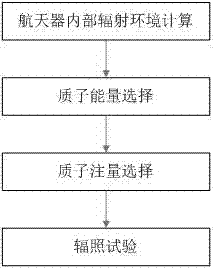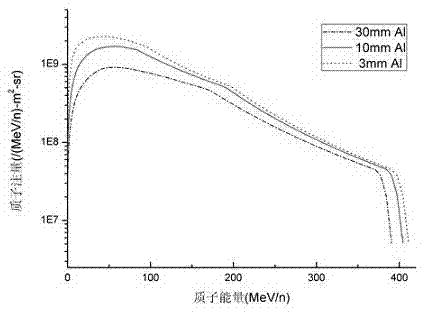Method for carrying out spatial displacement damage effect evaluation test through high energy protons
A technology of spatial displacement and damage effect, applied in the direction of measuring devices, instruments, measuring electricity, etc., can solve the problems of not giving the best proton energy selection method for the internal environment of the spacecraft, and not applying the displacement damage effect, etc. performance, accurate evaluation results
- Summary
- Abstract
- Description
- Claims
- Application Information
AI Technical Summary
Problems solved by technology
Method used
Image
Examples
Embodiment 1
[0037] A test method for evaluating the internal displacement damage effect of a low-earth orbit spacecraft with high-energy protons specifically includes the following steps:
[0038] Step 1. Calculation of the radiation environment inside the low earth orbit spacecraft
[0039] The space environment effect calculation software (such as Space Radiation, or CREME software) is used to calculate the orbital parameters of the earth-earth orbiting spacecraft. The proton model uses the AP8 model; the solar proton uses the ESP model (7 years of solar high years, 90% confidence level). The shielding thickness of the spacecraft is 3mm, 10mm, and 30mm aluminum respectively. The calculation results of proton differential energy spectrum inside the spacecraft can be found in image 3 .
[0040] Step 2, Select Proton
[0041] From image 3 The low-earth orbit (LEO) proton differential energy spectrum shown shows that in the interior of the low-earth orbit spacecraft, under the condit...
Embodiment 2
[0048] A test method for evaluating the internal displacement damage effect of a geosynchronous orbit spacecraft by using high-energy protons specifically includes the following steps:
[0049] Step 1. Calculation of the radiation environment inside the geosynchronous orbit spacecraft
[0050] Using the Space Radiation space environment effect calculation software, input the altitude and inclination of the spacecraft orbit (36000km, 0°), the space radiation environment model is: the AP8 model is used to capture protons; ). The shielding thickness of the spacecraft is 3mm, 10mm, and 30mm aluminum respectively. The calculation results of proton differential energy spectrum inside the spacecraft are as follows: Figure 4 shown.
[0051] Step 2, Select Proton
[0052] From Figure 4 The shown geosynchronous orbit (GEO) proton differential energy spectrum shows that inside the geosynchronous orbit spacecraft, under the condition of 3mm~30mm aluminum shielding, the proton energ...
PUM
 Login to View More
Login to View More Abstract
Description
Claims
Application Information
 Login to View More
Login to View More - R&D
- Intellectual Property
- Life Sciences
- Materials
- Tech Scout
- Unparalleled Data Quality
- Higher Quality Content
- 60% Fewer Hallucinations
Browse by: Latest US Patents, China's latest patents, Technical Efficacy Thesaurus, Application Domain, Technology Topic, Popular Technical Reports.
© 2025 PatSnap. All rights reserved.Legal|Privacy policy|Modern Slavery Act Transparency Statement|Sitemap|About US| Contact US: help@patsnap.com



